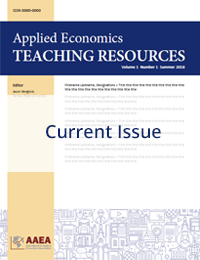Teaching Education Commentary
A Commentary on Extension Programming: An Overview of the Costs and Benefits of Patch-Burn Grazing Extension Program Development Through the Use of a Logic Model
Hannah M. Baker(a) and Hannah E. Shear(b)
(a)University of Florida, (b)Oklahoma State University
JEL Codes: JEL Codes: A10, Q15
Keywords: Cattle, Extension program development, graduate student, logic model, patch-burn grazing, rangeland management
First Published Online: May 22, 2024
Volume 6, Issue 2
Abstract
The Extension program discussed in this commentary was developed using a logic model to provide the missing economic analysis of patch-burn grazing in comparison to traditional rangeland management practices. It was submitted to the Graduate Student Extension Competition through the Agricultural and Applied Economics Association (AAEA) to take advantage of the opportunity to present patch-burn grazing as a potential cost-reducing and beneficial management practice to Oklahoma cow-calf producers. Delivery plans and communication methods for the program include fact sheets and budget tools, research articles, conference presentations, and workshops. The development of this Extension program centered around the economics of patch-burn grazing is supplemental to ongoing research by the Prairie Project. The Prairie Project utilizes outputs such as fact sheets, workshops, and social media to convey the benefits of patch-burn grazing, which has been shown to be effective. The opportunity to build an Extension program around research using a logic model allows young professionals to learn how to build a successful program.
References
Adhikari, S., O. Joshi, M.G. Sorice, and S.D. Fuhlendorf. 2023. “Factors Affecting the Adoption of Patch-Burn Grazing in the Southern Great Plains in the U.S.” Land Use Policy 125:106458.
Israel, G.D. 2001. “Using Logic Models for Program Development.” Gainesville: University of Florida Institute of Food and Agricultural Sciences. https://edis.ifas.ufl.edu/publication/WC041
Israel, G.D. 2021. “Logic Model Basics.” Gainesville: University of Florida Institute of Food and Agricultural Sciences. https://edis.ifas.ufl.edu/publication/WC106
Limb, R.F., S.D. Fuhlendorf, D.M. Engle, J.R. Weir, R.D. Elmore, and T.G. Bidwell. 2011. “Pyric–Herbivory and Cattle Performance in Grassland Ecosystems.” Rangeland Ecology & Management 64(6):659–663.
Smith, S. 2011. “Eastern Red-Cedar: Positives, Negatives and Management.” Ardmore OK: The Samuel Roberts Noble Foundation, pp. 1–8.
Twidwell, D., C.H. Bielski, R. Scholtz, and S.D. Fuhlendorf. 2021. “Advancing Fire Ecology in 21st Century Rangelands.” Rangeland Ecology & Management 78:201–212.
Articles in this issue
Game-Based Learning in Extension Education: An Assessment of the Impact on Consumer Learning and Behavior
Cristina Connolly and Stacey Stearns
Bringing Behavioral Change Education to Life: Incorporating Healthy Eating into College Classroom Teaching
Yanhong Jin, Mary L. Wagner, Yuxi Lei and Marion Reinson
Promoting Sustainable Products in Dry Consumer Packaged Goods: What Should a Grocer Do?
Michael A. Boland, Xiaowei Zhang
Renaissance Ag: Identifying the Who, How, and Where of Marketing a New Technology
Chanden Westover and Tanner McCarty
Financial Ratios of the U.S. Grocery Sector in a Changing Industry Landscape
Carlos J.O. Trejo-Pech and Susan White
A Commentary on Extension Programming: An Overview of the Costs and Benefits of Patch-Burn Grazing Extension Program Development Through the Use of a Logic Model
Hannah M. Baker and Hannah E. Shear


